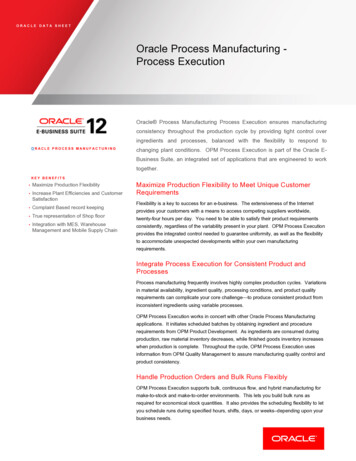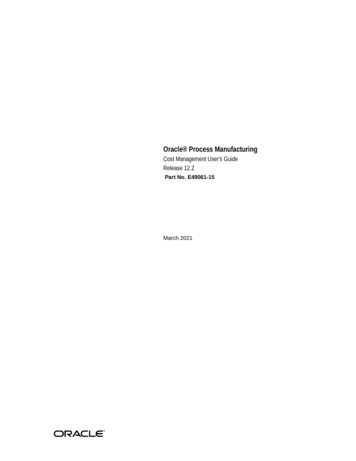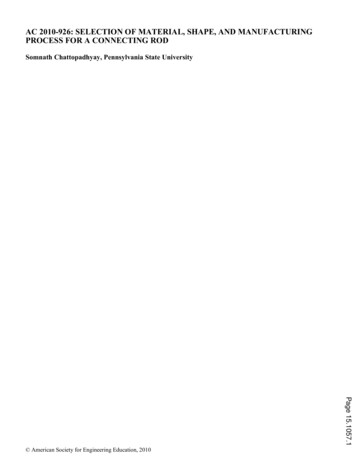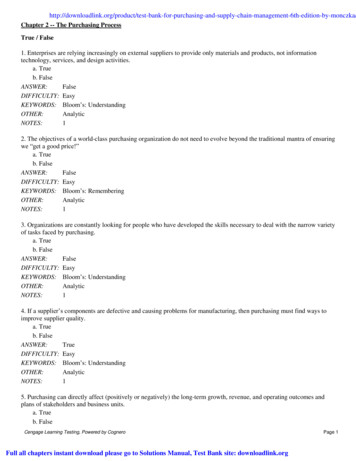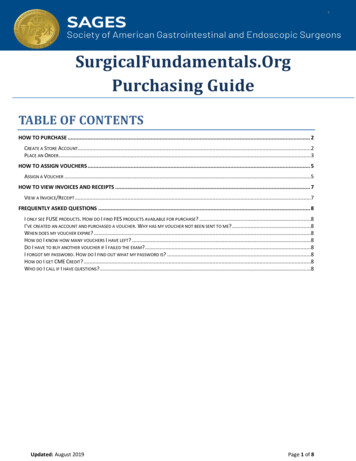
Transcription
School of Management & EconomicsPurchasingProcessintegrationmanufacturing industry in China—case study of three Chinese manufacturing companiesAuthor:Chen Ying831119Liu Weihua 850108Examiner:Helena ForslundTutor:Åsa Gustafssonin
Linnaeus University, School of Management and Economics, 5FE02E, Spring 2011ContentSummary . 4Acknowledgement . 61 Introduction . 71.1 Background . 71.2 Problem discussion . 91.3 Research question . 111.4 Purpose . 122 Methodology . 132.1 Research strategy—Qualitative . 132.2 Scientific approach--Deduction . 142.3 Scientific method—Multiple Case Study . 152.4 Sample selection . 162.5 Data collection . 172.5.1 Primary data . 172.5.2 Secondary data . 182.6Analytic techniques-Within-case study and Cross-case synthesis . 192.7 Scientific credibility . 202.8 Summary . 223 Theoretical framework . 233.1 Purchasing Process Model . 243.1.1 Determine specification . 253.1.2 Select supplier. 283.1.3 Contracting . 333.1.4 Ordering . 343.1.5 Expediting and evaluation . 353.1.6 Follow-up and evaluation . 353.2 Purchasing Process Integration . 363.2.1 Internal integration. 361
Linnaeus University, School of Management and Economics, 5FE02E, Spring 20113.2.2 External integration . 413.3 Summary of the theoretical framework . 444 Empirical material . 484.1 Foreign-funded company-Nypro Plastic & Molding (Suzhou) Co., Ltd . 484.1.1 Determine specification . 494.1.2 Select supplier. 504.1.3 Contracting . 514.1.4 Ordering . 524.1.5 Expediting and evaluation . 534.1.6 Follow-up and evaluation . 534.2 State-controlling company- Qingdao Haier Parts Purchasing Co. . 544.2.1 Determine specification . 554.2.2 Selecting suppliers . 564.2.3 Contracting . 574.2.4 Ordering . 574.2.5 Expediting and evaluation . 584.2.6 Follow-up and evaluation . 584.3 Private-owned company -Gao Xiang Knitting Weaving (Zhangjiagang) Co., Ltd. 594.3.1 Determine specification . 594.3.2 Select supplier. 604.3.3 Contracting . 604.3.4 Ordering . 614.3.5 Expediting and evaluation . 614.3.6 Follow-up and evaluation . 615 Analysis-current situation in some Chinese manufacturing companies . 625.1 Within-case Analysis . 635.1.1 Foreign-funded company-Nypro Plastic & Molding (Suzhou) Co., Ltd . 635.1.2 State-controlling company- Qingdao Haier Parts Purchasing Co. . 655.1.3 Private-owned company-Gao Xiang Knitting Weaving (Zhangjiagang) Co., Ltd. . 675.1.4 Summary of within-case analysis . 692
Linnaeus University, School of Management and Economics, 5FE02E, Spring 20115.2 Cross-Case Analysis . 715.3 Summary of within-case and cross-case analysis . 736 Suggestions- purchasing integration in some Chinese manufacturing companies . 776.1 Purchasing process integration in Nypro . 776.2 Purchasing process integration in Haier. 806.3 Purchasing process integration in Gao Xiang . 816.4 Summary of suggestion on purchasing process integration . 847 Conclusion and theory contribution . 877.1 Conclusion of findings . 877.2 Theoretical contribution . 887.3 Suggestions for future research . 89Reference . 90Appendix 1 . 943
Linnaeus University, School of Management and Economics, 5FE02E, Spring 2011SummaryTutor: Åsa GustafssonBackground: China could be seemed as a highly developing country. There are manyopportunities and challenges in China. Its preferential policies and huge potentialmarket attract a lot of foreign companies to come to China. Meanwhile, Chinesegovernment encourages the development of domestic enterprises. Therefore, atpresent there mainly coexist three forms of enterprises in China: foreign-fundedcompanies, private companies and state-controlling companies. In order to enhancecompetitiveness, almost every company in china has its own supply chain network.Supply Chain management plays an important role in Chinese companies.Research question:1. What is the current situation of purchasing process and purchasing processintegration for some manufacturers of different ownerships in China?2. How can purchasing process be integrated for some manufacturers of differentownerships in China from manufacture’s perspectives?Purpose: The purpose of this thesis is to study the current situation in purchasingprocess integration in Chinese manufacturing industry of three kinds of ownershipand evaluate the purchasing process of three kinds of companies in China. In addition,it gives some suggestions to remove potential obstacles and optimize the purchasingprocess; and aims to help the companies to gain competitive advantage in the longterm.Method: The empirical foundation for this thesis is intended to be on multiple casestudy method. It studies of the three types of manufacturing enterprises in China. Torepresent these three types of companies, three companies are chosen from each asselected research objects. Data is collected through semi-structure interviews, so thequestionnaire would be open-ended. Long-distance telephone interview withpurchasing managers and material managers separately for each company would be4
Linnaeus University, School of Management and Economics, 5FE02E, Spring 2011adopted.Conclusion: The purchasing process of three companies who represent three differenttypes of ownership is studied. It studies the current situation in purchasing processintegration in Chinese manufacturing industry of three kinds of ownership andevaluates the purchasing process of three kinds of companies in China. Then theobstacles in purchasing process are found out. Then suggestions on purchasingprocess integration are used to tackle these obstacles.Future Work: This thesis focuses on three manufacturing companies in China. Theresult of this thesis cannot represent all the obstacles in purchasing process inmanufacturing industry in China. But the purchasing process, characteristics, strengthand weakness are similar in the same type of ownership. Meanwhile, therecommendation on purchasing process integration also cannot solve all the obstaclesfound, due to the companies’ own condition. In future research, it recommends to addmore research companies. Furthermore, more studies could be included to identifycommon obstacles and dig out solutions related to purchasing process integration inChinese manufacturing industry.Keywords: supply chain management, purchasing process, supplier relationshipmanagement, process integration5
Linnaeus University, School of Management and Economics, 5FE02E, Spring 2011AcknowledgementThis Master Thesis has been written during spring 2011. It helps us to grasp theconcept of purchasing process integration and extensively develop our understandingand allow us to combine the concept with current situation of Chinese companies. It isnot possible for us to finish this thesis in time without support and beneficial feedbackfrom a lot of people. We should express our appreciation to them.First of all, we would like to show our gratitude to our tutor, Åsa Gustafsson. In thewhole process, she puts forward many useful suggestions and constructive feedbackto this thesis. Furthermore, we are obliged to thank our examiner, Helena Forslund,for her guidance and patience.In addition, we are greatly indebted to the interviewees who took extra time to acceptour interviews and provided us a lot of valuable empirical materials. They are MingTong, senior buyer from Nypro; Xin Lv, buyer from Ha
Purchasing Process integration in manufacturing industry in China — . Most SCM system softwares are used in medium and large enterprises in manufacturing industry. In other words, many small companies have not adopted SCM system, so SCM is not common adopted in China. It should be spread not only in large enterprises but also in small companies. Although the SCM has not been
